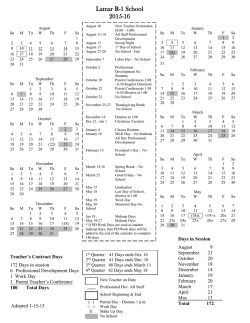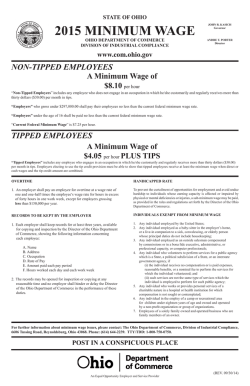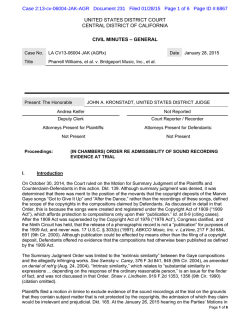
Cummings v. Greater Cleveland Regional Transit Authority et al
Case: 1:14-cv-01729-JG Doc #: 35 Filed: 01/29/15 1 of 13. PageID #: 304 UNITED STATES DISTRICT COURT NORTHERN DISTRICT OF OHIO ------------------------------------------------------: NOEL CUMMINGS : : Plaintiff, : : vs. : : GREATER CLEVELAND REGIONAL : TRANSIT AUTHORITY, et. al., : : Defendants. : : ------------------------------------------------------- CASE NO. 1:14-CV-01729 ORDER [Resolving Doc. 11] JAMES S. GWIN, UNITED STATES DISTRICT JUDGE: Plaintiff Noel Cummings alleges that her employer has discriminated and retaliated against her based on her race, gender, and gender identity.1/ Defendants Greater Cleveland Regional Transit Authority (“RTA”), and RTA employees Michael York, Felicia Brooks-Williams, Bruce Hampton, and Joseph Calabrese move to dismiss most of Cummings’s complaint for failure to state a claim.2/ For the following reasons, the Court GRANTS IN PART and DENIES IN PART Defendants’ motion to dismiss. I. Background Plaintiff Noel Cummings has worked at RTA for twenty-seven years; her current title is Manager of Service Quality. Cummings is African American and was born male in the state of Alabama. In 2001, Cummings underwent a surgical procedure anatomically changing her gender to 1 Doc. 1. 2 Doc. 11. -1- Case: 1:14-cv-01729-JG Doc #: 35 Filed: 01/29/15 2 of 13. PageID #: 305 Case No. 1:14-CV-01729 Gwin, J. female. Her amended Alabama birth certificate states that she is female.3/ Cummings generally alleges that since 2009, RTA has denied her equal pay and a series of promotions because of her race, gender, and gender identity. Cummings brings ten causes of action against RTA and against Michael York, RTA’s general manager of operations; Felicia BrooksWilliams, RTA’s manager for equal opportunity; Bruce Hampton, RTA’s deputy general manager of human resources; and Joseph Calabrese, RTA’s chief executive. Two hiring decisions are of primary importance. In November 2012, RTA’s Operations Division underwent a reorganization and several individuals received promotions to become “Acting Directors” of the Division. Despite expressing interest and having the requisite qualifications, Cummings was not promoted to Acting Director of Service Quality and did not receive a corresponding pay raise. Instead, an African American male was elevated to the Acting Director position.4/ In early 2014, RTA decided to hire a permanent Director of Service Quality. Despite Cummings’s interest in the job, an African American male was hired in her place. Cummings alleges she did not receive these promotions because of her gender, gender identity, and in retaliation because she had previously sued and filed administrative complaints against RTA.5/ II. Legal Standards “To survive a motion to dismiss, a complaint must contain sufficient factual matter, accepted 3 Doc. 1 at 3. 4 Id. at 6-7. 5 Id. at 8. -2- Case: 1:14-cv-01729-JG Doc #: 35 Filed: 01/29/15 3 of 13. PageID #: 306 Case No. 1:14-CV-01729 Gwin, J. as true, to ‘state a claim to relief that is plausible on its face.’”6/ The plausibility requirement is not “akin to a probability requirement,” but requires “more than a sheer possibility that the defendant has acted unlawfully.”7/ Federal Rule of Civil Procedure 8 provides requires that a complaint “contain . . . a short and plain statement of the claim showing that the pleader is entitled to relief.”8/ “Rule 8 marks a notable and generous departure from the hyper-technical, code-pleading regime of a prior era, but it does not unlock the doors of discovery for a plaintiff armed with nothing more than conclusions.”9/ In deciding a motion to dismiss under Rule 12(b)(6), “a court should assume the[] veracity” of “well-pleaded factual allegations.”10/ III. Analysis A. Cummings’s Standing to Pursue Gender Discrimination Claims as a Female RTA argues that because Cummings was born male, she has no standing to pursue any claims for gender discrimination as a female. RTA argues, “in the contemplation of Ohio jurisprudence, one’s gender at birth is one's gender throughout life.”11/ Cummings responds that her gender is an issue of fact not suitable for resolution on a motion to dismiss.12/ Defendants concede that certified public records, like Cummings’s Alabama birth certificate, receive the same “full faith and credit in every court within the United States and its Territories and 6 Ashcroft v. Iqbal, 556 U.S. 662, 678 (2009) (quoting Bell Atl. Corp. v. Twombly, 550 U.S. 544, 570 (2007)). 7 Id. 8 Fed. R. Civ. P. 8(a)(2). 9 Iqbal, 556 U.S. at 678-79 (citations omitted). 10 Id. 11 Gajovski v. Gajovski, 610 N.E.2d 431, 433 (Ohio Ct. App. 1991). 12 Doc. 27-1 at 9. -3- Case: 1:14-cv-01729-JG Doc #: 35 Filed: 01/29/15 4 of 13. PageID #: 307 Case No. 1:14-CV-01729 Gwin, J. Possessions as they have by law or usage in the courts of such State, Territory or Possession from which they are taken.”13/ In Alabama, “the evidentiary value of a certificate or record . . . which has been amended, shall be determined by the judicial or administrative body or official before whom the certificate is offered as evidence.”14/ Because the case is still at the motion to dismiss stage, no evidence has been, or need be, offered to the Court. Thus, it is premature for the Court to decide what evidentiary value to afford Cummings’s out of state birth certificate. At this juncture, all well-pleaded factual allegations in the complaint are accepted as true. Cummings states that she “identifies and considers herself a female” and is female from “a biological standpoint.”15/ Cummings has a valid birth certificate which indicates she is female. These statements are sufficient for Cummings to allege gender discrimination as a female. B. Count 1: Violation of R.C. § 4111.17: Ohio Equal Pay Act Cummings alleges that since February 2009, RTA has paid her less than male employees for equal work on jobs requiring equal skill under similar conditions, in violation of R.C. § 4111.17.16/ RTA argues that Cummings is not an employee as defined in § 4111.17, and in the alternative, that her claims are not timely.17/ Section 4111.17, entitled “Prohibiting discrimination in payment of wages,” does not define 13 28 U.S.C. § 1738. 14 Ala. Code 1975 § 22-9A-22(a)(2). 15 Doc. 1 at 3. 16 Id. at 8. 17 Doc. 11 at 2-5. -4- Case: 1:14-cv-01729-JG Doc #: 35 Filed: 01/29/15 5 of 13. PageID #: 308 Case No. 1:14-CV-01729 Gwin, J. the term employee.18/ But “[c]laims brought pursuant to R.C § 4111.17 are subject to the standards applied under the federal [Equal Pay Act19/].”20/ RTA argues that Cummings is exempt from § 4111.17 because she works in a bona fide executive, administrative, or professional capacity. But employees working in bona fide executive or administrative capacities are allowed to bring federal equal pay claims. RTA argues that the bona fide administrator exception – which bars some employees from bringing minimum wage and overtime claims21/ – should be read into the equal pay provision of § 4111.17.22/ Neither the statutory scheme nor attendant case law support this reading. Because § 4117.17 claims are subject to the same standards as Equal Pay Act claims, Cummings is able to bring her disparate pay claim regardless of how her position is characterized. Section 4111.17 requires that “[a]ny action arising under this section shall be initiated within one year after the date of violation.”23/ Cummings accepted a job that paid less than a male counterpart in 2009. Defendants argue that the violation therefore occurred in 2009, requiring her 18 Ohio Rev. Code § 4111.17. 19 29 U.S.C. § 206(d)(1) (“No employer having employees subject to any provisions of this section shall discriminate, within any establishment in which such employees are employed, between employees on the basis of sex by paying wages to employees in such establishment at a rate less than the rate at which he pays wages to employees of the opposite sex in such establishment for equal work on jobs the performance of which requires equal skill, effort, and responsibility, and which are performed under similar working conditions . . . .”). 20 Vehar v. Cole Nat’l. Grp., Inc., 251 F. App’x 993, 998 (6th Cir. 2007) (citing Birch v. Cuyahoga Cnty. Probate Court, 392 F.3d 151, 161 n.6 (6th Cir.2004)). 21 “[A]ny employee employed in a bona fide executive, administrative, or professional capacity” cannot bring a claim under 29 U.S.C. § 206. 29 U.S.C. § 213(a)(1). But this exception does not apply to “subsection (d) in the case of paragraph (1) of [§ 206],” which contains the Equal Pay Act provisions. 29 U.S.C. § 213(a). 22 RTA asks the Court to borrow the definition of “employee” used in R.C. § 4111.14(B) in analyzing Cummings’s claim under § 4111.17. But that more restrictive definition of “employee” is explicitly limited to the section of § 4111.14 in which it appears. The Court sees no reason to take a definition limited to a section dealing with minimum wage claims and apply it to a wholly different section dealing with equal pay claims. 23 Ohio Rev. Code § 4111.17. -5- Case: 1:14-cv-01729-JG Doc #: 35 Filed: 01/29/15 6 of 13. PageID #: 309 Case No. 1:14-CV-01729 Gwin, J. to bring suit by 2010.24/ Cummings argues for the “paycheck” theory, stating that each paycheck that pays her less than a comparable male coworker constitutes a new violation of § 4111.17 and starts the statute of limitations anew.25/ Cummings’s argument is correct. “Under Ohio law, each paycheck of unequal pay is a continuing violation, so the plaintiff may seek recovery for each day that the inequality persisted.”26/ Therefore, “only the last discriminatory act must fall within the one-year statute of limitations.”27/ Cummings alleges that she continues to receive unequal pay to this day: therefore, her claim for wage discrimination is timely. Thus, RTA’s motion to dismiss Count 1 is DENIED. C. Counts 2 and 3: Violation of R.C. § 4112.02(A): Gender Discrimination Cummings alleges that RTA paid her less than male counterparts because of her gender, and because she did not conform to male gender stereotypes in violation of R.C. § 4112.02(A).28/ RTA argues that Cummings has no standing to make this claim, and that it is merely an effort to avoid the statute of limitations of R.C. § 4111.17. The Court has already decided that Cummings has standing to pursue gender claims as a female and that her claim under R.C. § 4111.17 is timely. Section 4112.02(A) gives a separate and 24 Doc. 11 at 3-5. 25 Doc. 27-1 at 3-4. 26 Greenleaf v. DTG Operations, Inc., No. 2:09-CV-192, 2011 WL 883022, at *10 (S.D. Ohio Mar. 11, 2011) (citing Ifeatzka v. Millcraft Paper Co., 405 N.E.2d 264, 267 (Ohio 1980)). 27 Id. 28 Ohio Rev. Code § 4112.02(A). -6- Case: 1:14-cv-01729-JG Doc #: 35 Filed: 01/29/15 7 of 13. PageID #: 310 Case No. 1:14-CV-01729 Gwin, J. viable cause of action. Thus, RTA’s argument that claims under that section are “nothing more than recharacterizations” of other time-barred causes of action is unavailing.29/ Even if similar facts underpin two claims, Cummings may proceed with both. Therefore, RTA’s motion to dismiss counts 2 and 3 is DENIED. D. Count 4: Violation of R.C. § 4112.02(A): Racial Discrimination Cummings alleges racial discrimination on the grounds that “RTA took an adverse action in paying Plaintiff less than a demoted, Caucasian male subordinate who is a member of her staff.”30/ RTA argues that Cummings must be “similarly-situated to the non-protected employee in all relevant respects” to make such a claim.31/ RTA argues that Cummings is not similarly situated to her subordinate, and therefore unable to make out a claim for racial discrimination.32/ But determining whether employees are similarly situated is a fact-bound inquiry not proper for a motion to dismiss. Job titles are not dispositive to this inquiry, which also involves an examination of work responsibilities, prior experience, and performance on the job.33/ RTA may present facts demonstrating lack of similarity later on. For now, Cummings has a viable claim for racial discrimination because she alleges that the RTA has paid her less than a similarly situated white employee because she is black. 29 Doc. 11 at 6. 30 Doc. 1 at 10. 31 Dickens v. Interstate Brands Corp., 384 F. App’x 465, 468 (6th Cir. 2010) (quoting Ercegovich v. Goodyear Tire & Rubber Co., 154 F.3d 344, 353 (6th Cir.1998) (emphasis in original)). 32 Ohio Rev. Code § 4112.02 prohibits “any employer, because of the race . . . of any person, to discharge without just cause, to refuse to hire, or otherwise to discriminate against that person . . . [on] any matter directly or indirectly related to employment.” 33 Hatchett v. Health Care & Ret. Corp. of Am., 186 F. App’x 543, 548 (6th Cir. 2006). -7- Case: 1:14-cv-01729-JG Doc #: 35 Filed: 01/29/15 8 of 13. PageID #: 311 Case No. 1:14-CV-01729 Gwin, J. Thus, RTA’s motion to dismiss Count 4 is DENIED. E. Count 5: Failure to Promote in Violation of Public Policy Cummings argues that RTA and the individual defendants violated Ohio public policy when they failed to promote her because of her gender identity. Ohio recognizes a cause of action for wrongful termination in violation of public policy, a so-called Greeley claim.34/ But Ohio does not recognize a claim for failure to promote in violation of public policy.35/ Furthermore, Cummings argues that Cleveland Codified Ordinance 667.05 provides a clear public policy against discrimination based on gender identity. But a Greeley claim only exists where “an employee is discharged or disciplined in contravention of a clear public policy articulated in the Ohio or United States Constitution, federal or state statutes, administrative rules and regulations, or common law. . . .”36/ City ordinances are not part of this list. Therefore, they not are potential sources of public policy that can support a wrongful discharge claim. Thus, the motion to dismiss Count 5 as to all Defendants is GRANTED. F. Counts 6 and 7: Equal Protection and First Amendment Retaliation under 42 U.S.C. § 1983 To make a claim under 42 U.S.C. § 1983, a plaintiff must show deprivation of her Constitutional rights committed under color of state law.37/ Cummings makes two § 1983 claims. 34 See Greeley v. Miami Valley Maint. Contractors, Inc., 551 N.E.2d 981 (Ohio 1990). 35 Evans v. Toys R Us, Inc., 221 F.3d 1334, 2000 WL 761803 at *6 (6th Cir. 2000) (“The district court correctly concluded that [Plaintiff] could not prevail on his public policy claims under Ohio law because Ohio courts do not recognize policy claims for failure to promote.”). 36 Dohme v. Eurand Am., Inc., 130 Ohio St. 3d 168, 171 (2011). 37 Barkovic v. Hogan, 505 F. App’x 496, 499 (6th Cir. 2012). -8- Case: 1:14-cv-01729-JG Doc #: 35 Filed: 01/29/15 9 of 13. PageID #: 312 Case No. 1:14-CV-01729 Gwin, J. First, Cummings alleges that Defendants denied her equal employment opportunities because of her gender identity, thus denying her equal protection of the law in violation of the Fourteenth Amendment.38/ Second, Cummings alleges that Defendants engaged in First Amendment retaliation because they took adverse employment actions against her because she earlier sued RTA.39/ RTA argues that it cannot be liable under § 1983 because Cummings has failed to allege that RTA had a policy or custom of discriminating on the basis of gender identity or retaliating against employees who file lawsuits. RTA is correct that it is not necessarily liable for the alleged constitutional violations of its employees. RTA may be liable if Cummings can show an “officially executed policy, or the toleration of a custom . . . [that] leads to, causes, or results in the deprivation of a constitutionally protected right.”40/ Cummings has done the bare minimum to allege that a custom or practice of discrimination in violation of the Fourteenth Amendment and retaliation in violation of the First Amendment exists at RTA. Cummings alleges she suffered discrimination for years and while serving in various positions. Her complaint alleges “unlawful employment practices” and discrimination that has continued during administrative investigations, departmental reorganizations, and hiring for new roles.41/ With regard to First Amendment retaliation, she alleges several instances of retaliation for requesting raises, making administrative complaints, and eventually filing a lawsuit.42/ She asks the 38 Doc. 1 at 10. 39 Id. at 11. 40 Doe v. Claiborne Cnty., Tenn. By & Through Claiborne Cnty. Bd. of Educ., 103 F.3d 495, 507 (6th Cir. 1996). 41 Doc. 1 at 11. 42 Id. at 5. -9- Case: 1:14-cv-01729-JG Doc #: 35 Filed: 01/29/15 10 of 13. PageID #: 313 Case No. 1:14-CV-01729 Gwin, J. Court to “infer a policy or custom of retaliation and discrimination.”43/ Because the Court accepts the pleaded facts as true and draws inferences in her favor at this juncture, her § 1983 claims against RTA may proceed. Individual Defendants Calabrese, Hampton, and Brooks-Williams move to dismiss both § 1983 claims because the claims do not specify their “direct, active involvement in the alleged constitutional violations.”44/ Defendants are correct that in a §1983 claim, “[t]here must be a showing that the supervisor encouraged the specific incident of misconduct or in some other way directly participated in it.”45/ In her complaint, Cummings alleges that her constitutional rights were violated “at the direction and/or with the knowledge and consent of Defendants.”46/ Thus, she has met her initial burden to at least plead that the individual defendants were somehow directly involved in the allegedly discriminatory conduct. The Defendants can marshal evidence to counter this claim later. Finally, the Defendants argue that Cummings cannot state a claim for retaliation under the Fourteenth Amendment, and that Cummings can only allege violations of § 1983 that occurred within two years of the filing of her complaint.47/ Cummings concedes both points in her reply motion.48/ Thus, the Court GRANTS Defendants’s motion to dismiss Cummings’s claim for retaliation under the Fourteenth Amendment, and to dismiss claims for § 1983 violations occurring 43 Doc. 27-1 at 15. 44 Doc. 11 at 15. 45 Stewart v. Taft, 235 F. Supp. 2d 763, 767 (N.D. Ohio 2002). 46 Doc. 1 at 11. 47 Doc. 11 at 16-17. 48 Doc. 27-1 at 15 n.4 (“Plaintiff does not oppose Defendants’ motion with respect to the §1983 equal protection claim with respect to retaliation. Furthermore, Plaintiff acknowledges that her claim only goes back for the two years prior to the filing of the instant lawsuit.”). -10- Case: 1:14-cv-01729-JG Doc #: 35 Filed: 01/29/15 11 of 13. PageID #: 314 Case No. 1:14-CV-01729 Gwin, J. before August 7, 2012. Otherwise, the motion to dismiss Counts 6 and 7 as to RTA and Calabrese, Hampton, and Brooks-Williams is DENIED. G. Counts 8 and 9: Retaliation under R.C. § 4112.02(I) and Aiding and Abetting Unlawful Practice under § R.C. 4112(J) Cummings brings a claim for retaliation under R.C § 4112.02(I) which generally mirrors her claim for First Amendment retaliation. That section prohibits “any person to discriminate in any manner against any other person because that person has . . . made a charge, testified, assisted, or participated in any manner in any investigation, proceeding, or hearing . . . .”49/ Defendants Calabrese, Hampton, and Brooks-Williams Defendants again respond that Cummings has not specifically alleged that they individually took any adverse action against her. As with her claim for First Amendment retaliation, Cummings has at least named the individual Defendants and alleged that they engaged in retaliatory conduct. She has stated that she engaged in protected activity and suffered adverse consequences as a result. Cummings has stated that each Defendant was involved: she is not yet obligated to provide evidence to prove that each named individual was, in fact, involved. Cummings’s claim under 4112.02(J), which prohibits any “person to aid, abet, incite, compel, or coerce the doing of any act declared by this section to be an unlawful discriminatory practice,” survives on similar grounds.50/ Cummings has pleaded that the individual Defendants were involved 49 Ohio Rev. Code§ 4112.02(I). 50 Ohio Rev. Code§ 4112.02(J). -11- Case: 1:14-cv-01729-JG Doc #: 35 Filed: 01/29/15 12 of 13. PageID #: 315 Case No. 1:14-CV-01729 Gwin, J. in or actually made the decision to retaliate against her. Thus, she meets the standard for alleging that the individual Defendants at least aided or abetted unlawful conduct. Therefore, Calabrese, Hampton, and Brooks-Williams’s motion to dismiss Counts 8 and 9 is DENIED. H. Count 10: Intentional Infliction of Emotional Distress Finally, Cummings makes a claim for intentional infliction of emotional distress (IIED) against RTA and all Defendants. In this count, Cummings pleads nothing but bare legal conclusions, alleging that “Defendants’ intentional conduct towards Plaintiff has been extreme and outrageous.”51/ Defendants are correct that the standard for stating an IIED claim in Ohio is exacting.52/ The “outrageousness” element is a question of law for the Court to decide, and “[i]t is well accepted that intentional infliction of emotional distress claims may entirely appropriately be dealt with on summary judgment or in a motion to dismiss.”53/ Generally speaking, “discrimination, by itself, is insufficient to support an [IIED] claim.”54/ Even accepting all facts as true and drawing inferences in Cummings’s favor, none of the allegations in her complaint allege extreme and outrageous conduct. She claims that she did not receive a series of promotions and pay raises for discriminatory and retaliatory reasons. Courts have 51 Doc. 1 at 12. 52 See Baab v. AMR Servs. Corp., 811 F. Supp. 1246, 1269 (N.D. Ohio 1993) (“[T]o say that Ohio courts narrowly define ‘extreme and outrageous conduct’ would be something of an understatement.”). 53 Miller v. Currie, 50 F.3d 373, 377-78 (6th Cir. 1995) (denying a motion to dismiss an IIED claim because “[i]t is certainly within the realm of imagination that hiding a ninety-eight year old, physically infirm mother from her adult daughter, and causing the daughter to be arrested for attempting to visit her mother, could under some set of facts constitute ‘extreme and outrageous’ conduct, and present a case ‘in which the recitation of the facts to an average member of the community would arouse his resentment against the actor, and lead him to exclaim, ‘Outrageous!’’”). 54 Fuelling v. New Vision Med. Labs. LLC, 284 F. App’x 247, 261 (6th Cir. 2008). -12- Case: 1:14-cv-01729-JG Doc #: 35 Filed: 01/29/15 13 of 13. PageID #: 316 Case No. 1:14-CV-01729 Gwin, J. dismissed IIED complaints with allegations of considerably more egregious behavior because those complaints did not state a claim for outrageous conduct as a matter of law.55/ On this count, Cummings is armed with nothing more than legal conclusions. Therefore, the motion to dismiss her IIED claim as to all Defendants is GRANTED. IV. Conclusion For the reasons above, the Court GRANTS the motions to dismiss Counts 5 and 10 as to all Defendants. The Court GRANTS in part the motion to dismiss Counts 6 and 7. The motions to dismiss all other counts are DENIED. IT IS SO ORDERED. s/ James S. Gwin JAMES S. GWIN UNITED STATES DISTRICT JUDGE Dated: January 29, 2015 55 See Braun v. Ultimate Jetcharters, Inc., No. 5:12CV1635, 2013 WL 623495, at *12 (N.D. Ohio Feb. 19, 2013) (“Here, plaintiff contends that Rossi and Wells yelled, threatened, and defamed her, continually telling others that she was insubordinate, unprofessional, young, and wild, allegedly because she did not conform to their gender stereotypes. Courts have found, as a matter of law, that discriminatory conduct far more ‘extreme’ than the conduct alleged here does not meet the ‘outrageousness” standard.’”); see also id. (collecting cases). -13-
© Copyright 2026




